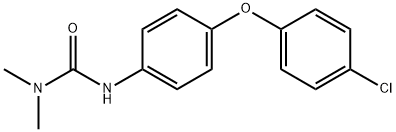
CHLOROXURON
- русский язык имя
- английское имяCHLOROXURON
- CAS №1982-47-4
- CBNumberCB7113279
- ФормулаC15H15ClN2O2
- мольный вес290.74
- EINECS217-843-7
- номер MDLMFCD00128024
- файл Mol1982-47-4.mol
химическое свойство
| Температура плавления | 151-152℃ |
| Температура кипения | 459.3±41.0 °C(Predicted) |
| плотность | 1.270 |
| показатель преломления | 1.5200 (estimate) |
| Fp | >100 °C |
| температура хранения | 0-6°C |
| растворимость | Chloroform (Slightly), DMSO (Slightly) |
| пка | 14.37±0.70(Predicted) |
| Растворимость в воде | 3.7mg/L(20 ºC) |
| БРН | 2814275 |
| Стабильность | Stable. Incompatible with strong oxidizing agents. |
| FDA UNII | QER23C88ME |
| Система регистрации веществ EPA | Chloroxuron (1982-47-4) |
| Коды опасности | N |
| Заявления о рисках | 50/53 |
| Заявления о безопасности | 60-61 |
| РИДАДР | UN3077 9/PG 3 |
| WGK Германия | 2 |
| RTECS | YS6125000 |
| Банк данных об опасных веществах | 1982-47-4(Hazardous Substances Data) |
| Токсичность | LC50 (96-hour) for rainbow trout >100 mg/L, bluegill sunfish 28 mg/L and crucian carp >150 mg/L (Hartley and Kidd, 1987); LC50 (48-hour) for bluegill sunfish 25.0 mg/L (Verschueren, 1983); acute oral LD50 for male and female rats 3,700 and 5,400 mg/kg, respectively (Hartley and Kidd, 1987). |
рисовальное письмо(GHS)
-
рисовальное письмо(GHS)


-
сигнальный язык
предупреждение
-
вредная бумага
H400:Чрезвычайно токсично для водных организмов.
H332:Вредно при вдыхании.
-
оператор предупредительных мер
P273:Избегать попадания в окружающую среду.
P304+P340+P312:ПРИ ВДЫХАНИИ: Свежий воздух, покой. Обратиться за медицинской помощью при плохом самочувствии.
CHLOROXURON химические свойства, назначение, производство
Химические свойства
Chloroxuron is a combustible, colorless crystalline solidИспользование
Herbicide.Общее описание
Odorless colorless powder or white crystals. Used as a selective pre- and early post-emergence herbicide in soybeans, strawberries, various vegetable crops and ornamentals. Root- and foliage-absorbed herbicide selective in leek, celery, onion, carrot and strawberry.Профиль реактивности
Fire may produce irritating or poisonous gases. When heated to decomposition CHLOROXURON emits very toxic fumes of chlorides and nitrogen oxides. [EPA, 1998].Угроза здоровью
This is highly toxic by ingestion. Under certain conditions, CHLOROXURON will form carcinogenic dimethylnitrosamine.Пожароопасность
(Non-Specific -- Pesticide, Solid, n.o.s.) Fire may produce irritating or poisonous gases. When heated to decomposition CHLOROXURON emits very toxic fumes of chlorides and nitrogen oxides.Возможный контакт
A potential danger to those involved in the manufacture, formulation, and application of chloroxuron for use as a selective pre- and early postemergency herbicide in soybeans, strawberries; various vegetable crops, and ornamentals. It is a root- and foliageabsorbed herbicide selective in leek, celery, onion, carrot, and strawberry.Экологическая судьба
Soil. Hartley and Kidd (1987) reported 4-(4-chlorophenoxy)aniline as a soil metabolite. Chloroxuron was degraded by microorganisms in humus soil and a sandy loam to form N′-(4-chlorophenoxy)phenyl-N-methylurea, N′-(4-chloro-phenoxy)phenylurea and (4- chlorophenoxy)aniline and two minor unidentified compounds (Geissbühler et al., 1963a). Residual activity in soil is limited to approximately 4 months (Hartley and Kidd, 1987).Plant. In plants, chloroxuron is degraded to monomethylated and demethylated derivatives followed by decarboxylation forming 4-(4-chlorophenoxy)aniline (Humburg et al., 1989)
Photolytic. The UV irradiation of an aqueous solution of chloroxuron for 13 hours resulted in 90% decomposition of the herbicide. Products identified (% yield) were mono- (2.2%) and didemethylated (4.2%) products and carbon dioxide (64%) (Plimmer
Chemical/Physical. Hydrolyzes in strong acids and bases forming 4-(4-chloro-phenoxy)aniline (Hartley and Kidd, 1987). Emits toxic fumes of nitrogen oxides, cyanides and chlorine when heated to decomposition (Sax and Lewis, 1987)
Перевозки
UN2767 Phenylurea pesticides, solid, toxic, Hazard Class: 6.1; Labels: 6.1-Poisonous materialsНесовместимости
Incompatible with oxidizers (chlorates, nitrates, peroxides, permanganates, perchlorates, chlorine, bromine, fluorine, etc.); contact may cause fires or explosions. Keep away from alkaline materials, strong bases, strong acids, oxoacids, epoxides.Утилизация отходов
Incinerate in a unit with effluent gas scrubbing. In accordance with 40CFR165, follow recommendations for the disposal of pesticides and pesticide containers. Must be disposed properly by following package label directions or by contacting your local or federal environmental control agency, or by contacting your regional EPA office.CHLOROXURON поставщик
| поставщик | телефон | страна | номенклатура продукции | благоприятные условия |
|---|---|---|---|---|
| 18871490254 | CHINA | 28172 | 58 | |
| +86-023-6139-8061 +86-86-13650506873 |
China | 39894 | 58 | |
| +86-89586680 +86-13289823923 |
China | 8670 | 58 | |
| 010-82848833 400-666-7788 |
China | 96815 | 76 | |
| China | 12984 | 57 | ||
| 400-1166-196 18981987031 |
China | 11707 | 57 | |
| 025-57798810 | China | 3239 | 55 | |
| 022-6537-8550 15522853686 |
China | 4511 | 55 | |
| 18620099427 | China | 17687 | 55 | |
| 021-52907766-8042 | China | 9941 | 58 |